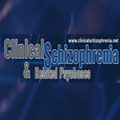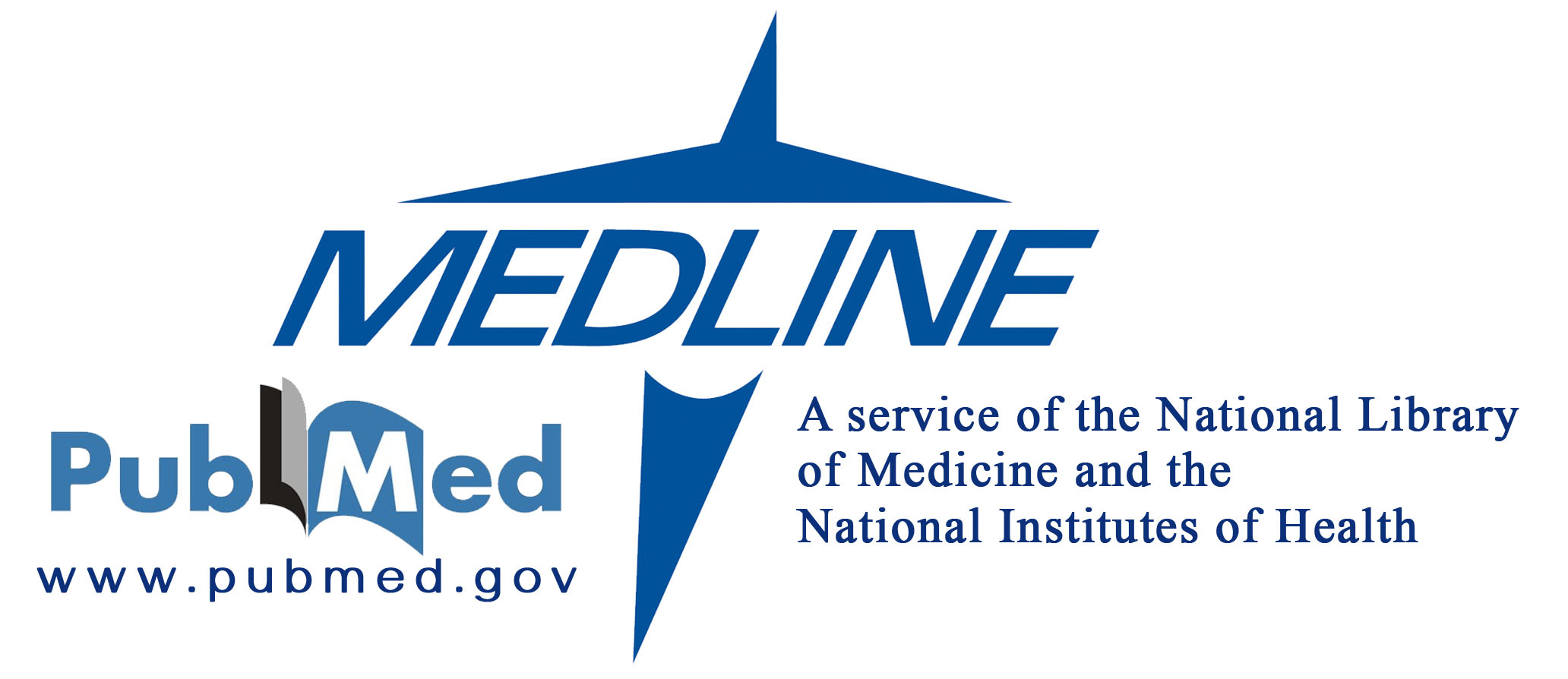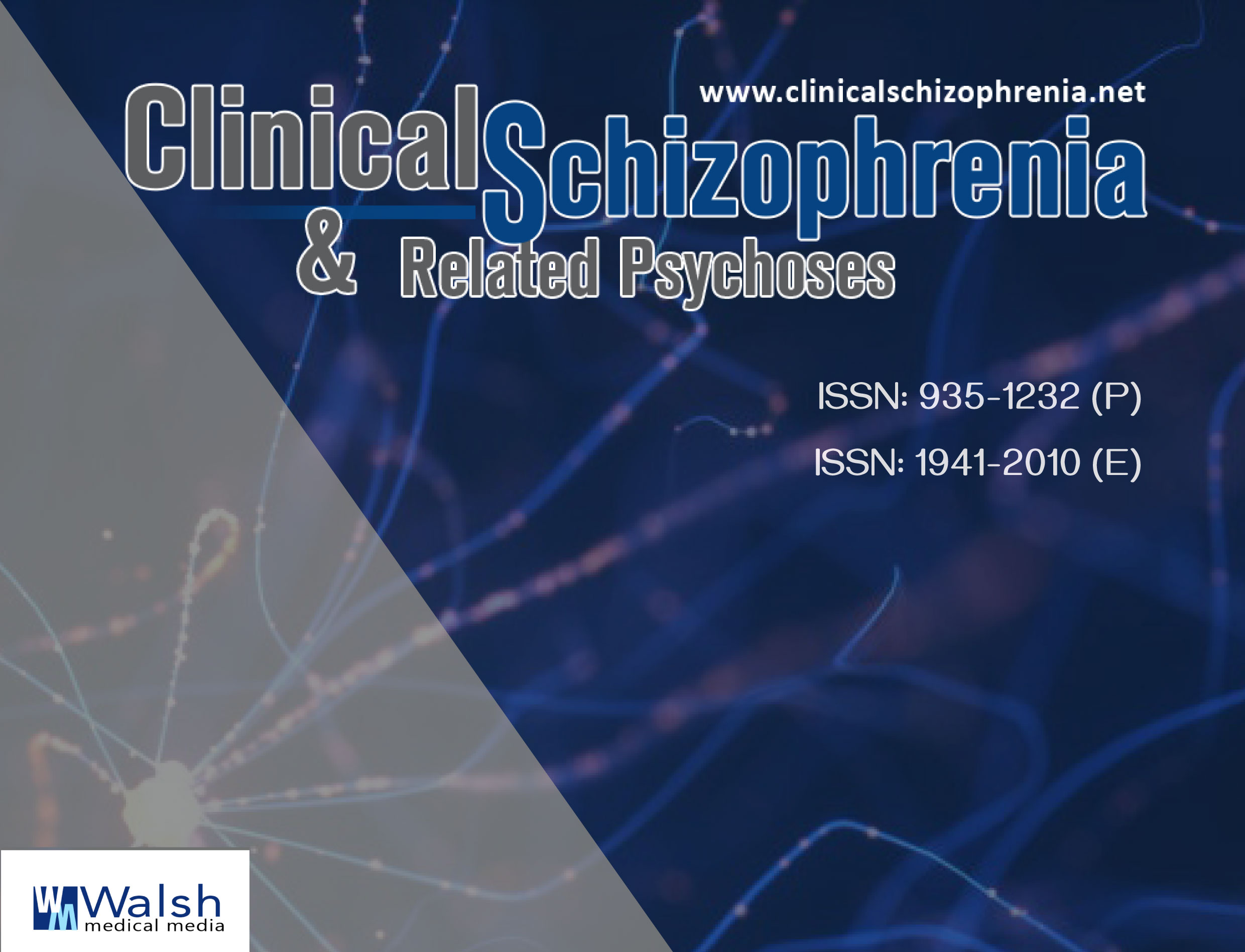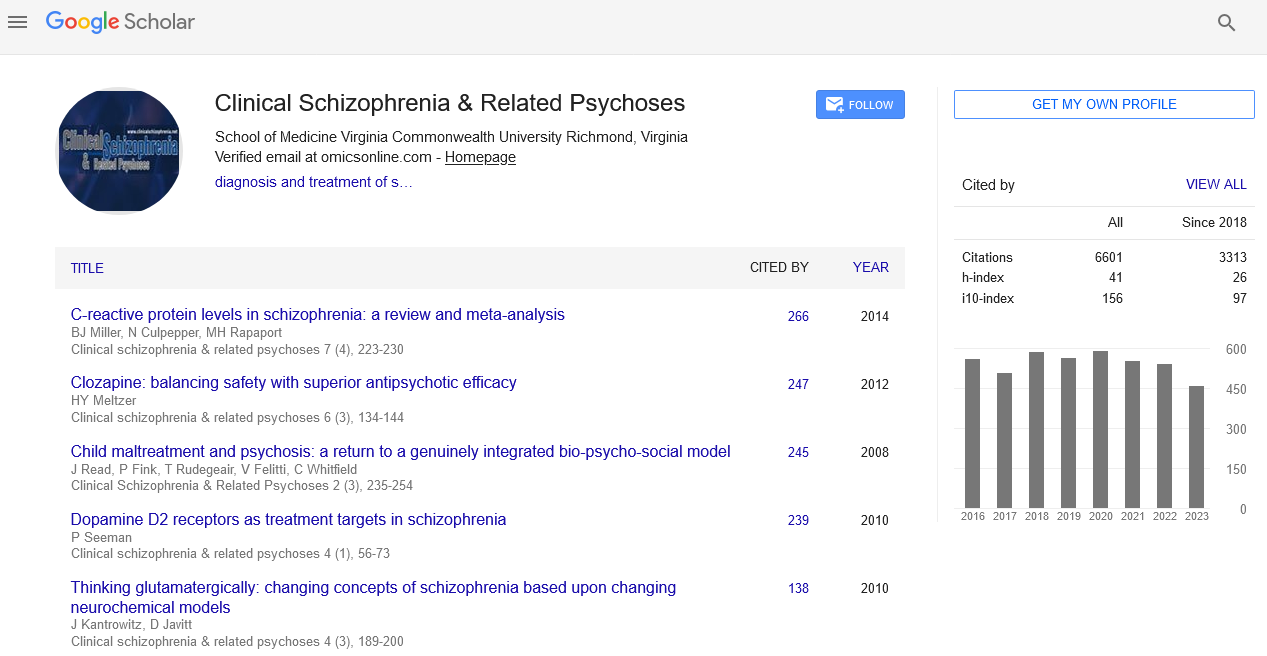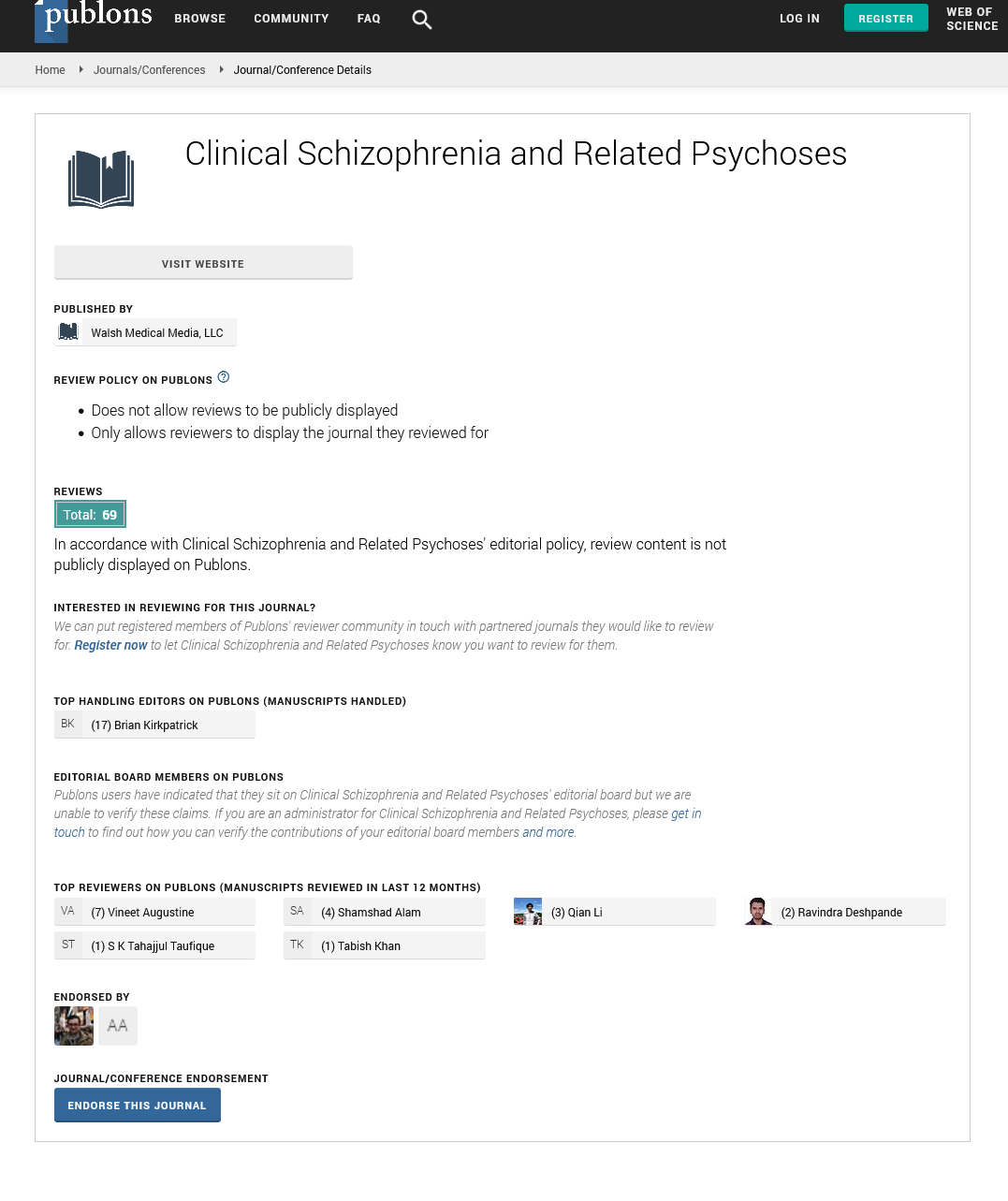Review - Clinical Schizophrenia & Related Psychoses ( 2021) Volume 0, Issue 0
Mohita Singh, Department of Physiology, Government Medical College and Hospital, Jammu and Kashmir, India, Email: mohitasingh1512@gmail.com
Received: 21-Oct-2021 Accepted Date: Nov 04, 2021 ; Published: 11-Nov-2021
Abstract
Cerebellum means little brain. Purkinje Cell (PC) and deep cerebellar nucleus form the functional unit of cerebellum. It has various motor functions like control of posture and balance, smoothening and coordination of skilled voluntary movements, control of ballistic movements, control of muscle tone and stretch reflex, learning and improvement of motor skills, turn on/off function and has role in various vestibular functions However, very little is known about the extra-motor functions of cerebellum. From its role in cognition to emotional regulation, cerebellum has significant contribution in scientific discoveries and intuition. Pathophysiology of psychiatric disorders and addiction to drugs has also been linked to cerebellum. Newer horizons in cerebellar research include optogenetic manipulation of cerebellum, non-invasive electrical and magnetic stimulation for treatment of symptoms and artificial cerebellum controlling robotic arm with human like precision.
https://sporbahisleri.blogaaja.fi http://sporbahisleri.parsiblog.com https://spor-bahisleri.jimdosite.com https://sporbahisleri.edublogs.org https://sporbahisleri.websites.co.in https://sporbahisleri.podia.com https://sporbahisleri7.wordpress.com https://sporbahisleri.jigsy.com https://niwn-chroiaty-mcieung.yolasite.com https://spor-bahisleri.mywebselfsite.net https://sporbahisleri.mystrikingly.com https://sporbahisleri.splashthat.com https://sporbahisleri1.webnode.com.tr https://sporbahisleri.odoo.com http://sporbahisleri.creatorlink.net http://www.geocities.ws/sporbahisleri/ https://spor-s-site.thinkific.com https://artistecard.com/sporbahisleri https://sporbahisleri.estranky.cz https://spor-bahisleri.mozellosite.com https://651be6b563e56.site123.me https://betsitesiinceleme.blogspot.com https://sporbahisleri.hashnode.dev https://sporbahislerim.wixsite.com/spor-bahisleri https://sporbahislerix.weebly.com https://sites.google.com/view/betsiteleri https://codepen.io/sporbahisleri https://sporbahisleri.bcz.com https://www.smore.com/6rsb9
Keywords
Artificial cerebellum • Emotional regulation •Intuition • Language processing • Scientific discoveries
Introduction
Cerebellum, the silent area of brain, is located in posterior cranial fossa and is divided into anterior, posterior and flocculonodular lobes by primary and posterolateral fissures. Longitudinally, it is divided into vermis, intermediate zone and lateral hemisphere with each zone having specific functions. Inputs and outputs are via superior, middle and inferior cerebellar peduncles. Purkinje cell exhibit two types of action potentials: mossy fiber parallel fiber stimulation evokes simple spike while climbing fiber stimulation evokes complex spike [1].
Research on extra-motor function of cerebellum has proved to be beneficial in understanding pathophysiology of disorders like psychiatric illness, drug addiction etc. Also, innovations in this field has provided new scope in treatment of ataxias, levodopa induced dyskinesia in Parkinson’s disease etc. This article enriches us with the knowledge about newer horizons in cerebellar research and its applications.
Extra-Motor Functions
Cognition, executive function and language
Parallel role of cerebellum has been established in control of skillful motor movements and process of thinking and reasoning [2]. With repeated performance of any skillful motor movement, feedback is send to cerebellum where internal model of action is formed. Similarly for any cognitive function, under the control of pre-frontal cortex, cerebellum forms psychological model born from thoughts and imagination [3]. The ability to regulate speed, capacity, consistency and appropriateness of cognitive processes and to detect and correct mismatch between reality and imagination has been linked to cerebellum [4]. Functional neuroimaging studies in normal subjects showed cerebellar size to be weakly correlated to IQ and memory retention (cognitive abilities) in association with the respective cortical areas with which it is connected [5].
Another aspect of cognition involving role of cerebellum is social cognition which is to understand emotional and psychological state of an individual via interpretation of signals obtained in form of gestures, expression of face and body language [6]. Parts involved in social cognition include orbitofrontal cortex, anterior cingular cortex and temporoparietal junction [7]. Neuropsychological testing on spinocerebellar ataxia patients reported moderate to severe executive dysfunction [8]. In patients of cerebellar disease, cognitive impairment similar to that with frontal lobe lesion along-with visuospatial dysfunction, language perception, implicit learning and memory impairment were reported [9]. Cerebellar lesion leads to dysmetria of thoughts and behaviour; and cerebellar cognitive affective syndrome [10].
Cerebellum has been proposed to be involved in evolution of human language. After verbal inputs, the subsequent thought process, working memory and executive processes required for speech perception and production involves cerebellum [11], particularly the posterior lobe and lobule IV. While the function of logical reasoning and language processing involves the right side of cerebellum, visuospatial and attention skills involve the left side of cerebellum [12]. The controversial role of cerebellum in language production and interpretation was studied on patients of cerebellar tumour [13]. Removal of tumour lead to inability to speak that could not be explained by dysarthria alone and role of cerebellum came into focus [14]. For determining verbal fluency, grammar processing and the ability to identify and correct language mistakes and writing skills, the neural circuitry of cerebellum involved is right hemisphere, dentate nucleus alongwith multiple cerebello-cortical connections with cerebral cortical language areas [15].
Emotion regulation
Regulation of emotions requires connection between cerebellum (fastigial nucleus, vermis and flocculonodular lobe considered limbic cerebellum) and limbic region including amygdala, hippocampus and septal nucleus; [16] while reciprocal connection between cerebellum and brain stem areas containing neurotransmitters like 5-HT, NE, dopamine is responsible for regulation of mood [17]. When cerebellar function inhibition was carried out via repetitive Trans Magnetic Stimulation (TMS), it lead to increase in experience of negative mood resulting from mismanagement of emotion demonstrating the influence of cerebellum on emotional regulation [18]. When emotions evoking visual stimulus was shown to cerebellar stroke patients, they responded by increase in unpleasant experience in response to happiness promoting stimulus and unpleasant experience to frightening stimuli that were similar to healthy volunteers as demonstrated on water PET scan. There was bilateral reduction in amygdale activity and increase in ventromedial pre-frontal cortex, cingulate, insula and pulvinar area activity in stroke patients. This study supports the hypothesis that cerebellar lesions lead to perseverance of evolutionary unpleasant experience with loss of pleasant emotions [19]. The response to stimulus was probably due to cerebellum projection to sub-cortical structures (limbic system) and frontal areas [20].
Role in behaviour
Non-complaint behaviour and changes in personality of an individual is due to pathology of midline and vermal cerebellar regions [21]. In another study [22], improvement in refractory cases of depression, psychosis and behavioural problems in patients diagnosed with schizophrenia, depression, epilepsy and organic brain syndrome on anterior cerebellum stimulation by electrodes was observed. The neural circuitry involves vermal lobules IV, V; superior cerebellar peduncles and interpositus nucleus of cerebellum. During analysis of fear in rodents, they acquired initial fixed immobile posture in presence of stimulus evoking threat followed by adaptation to this freezing behaviour and the rodent began to sniff and move around [23]. In another study on rodents, the role of cerebellum was established in consolidation of fear memories [24].
Conscious episodic memory retrieval
In a pure thought experiment on human subjects with no motor or sensory input/ output, PET scan was carried out. On intentional recall of a specific past personal experience by subjects, there were changes in blood flow in areas of right lateral cerebellum, left medial dorsal thalamus, medial and left orbital frontal cortex, anterior cingulate, and left parietal regions. The cognitive role of cerebellum was proposed via involvement of interactive cortico-cerebellar network that initiates and monitors conscious retrieval of episodic memory [25].
Decision making under uncertainty
Uncertain conditions requiring probabilistic reasoning ability involves the role of neo-cerebellum along-with pre-motor cortex, inferior parietal lobe and medial occipital cortex for decision making. For every uncertain event occurring in external world, an internal model of the event is created by neo-cerebellum that works as a base model for future predictive role [26].
Role in music
With practice of music, there is increment in working memory ability and executive processes utilizing internal models created by cerebellum [27]. Cerebellar size is more in male musicians compared to their female counterpart and correlating positively with frequency and intensity of music practice [28]. Cerebellum is believed to be involved in rhythm perception and synchronization [29]. Even the pitch changes and rhythm irregularities are detected faster and more accurately in musicians than non- musicians, an ability that may depend on cerebellar involvement [30]. Music also enhances performance with decrease in error rates and improvement in reaction time [31].
Role in scientific discoveries
This role involves various Cerebro-cerebellar mechanisms. During problem solving, there is recruitment of internal models of cerebellum created by generation of repetitive pattern of thoughts and ideas. Unconscious perception of these internal models along-with working memory abilities and attention concentration skills leads to goal attainment. In this process, there is also requirement of internal model for unconscious prediction and anticipation of similar future environmental events [32].
During problem solving, all processes of cerebellar sequence detection and prediction processes along-with unconscious forward predicting internal model of cerebellum are merged [33]. These unconsciously learned newly blended forward predicting internal models leading to innovations and scientific discoveries [34] are send to consciousness in pre-frontal and parieto-lateral association cortex that is experienced as sudden intuition [35]. Intuition is perceived by an individual when he thinks about the same topic repeatedly such that the thought becomes more and more implicit (unconscious involvement requiring less and less conscious effort). This requires the use of cerebellum in regulation of both action and thought mainly by use of the internal models [36].
Hormones in Relation to Cerebellum
Thyroid hormone
A very crucial hormone in cerebellar development, its deficiency in perinatal period leads to perinatal hypothyroidism that causes reduction in growth and branching of PC dendrites; reduction in synapse between PC and granule cell; synaptic connectivity within cerebellar cortex; and connectivity between parallel fibre and PC. Granule cell migration to internal granular layer is also delayed [37]. Acquired hypothyroidism, on the other hand presents with cerebellar ataxias, symptoms being typically reversed by thyroid replacement therapy [38].
Steroids
During postnatal life, PC possesses steroidogenic enzymes progesterone and allopregnenolone [39], and the source of progesterone in neonatal period is cholesterol. Progesterone promotes dendritic growth and spine formation in PC [40]. Link has been established between steroidogenesis and development of cerebellar circuit acting via BDNF. Scientists are of view that even motor learning and neurosteroidogenesis are related [41].
Role of Cerebellum in Psychopathology of Disorders
Psychiatric disorder
In schizophrenia, there is disturbance in cortico-thalamic-cerebellarcortical circuit [42]. Cerebellar functional imaging in schizophrenia patients exhibit abnormalities in cerebellar blood flow. Also, there occur abnormalities in excitatory/ inhibitory tone, cerebellar size, non declarative learning, linear density of Purkinje Cells (PC) along-with decreased excitatory input to PC and development of neurological aspects of disease [43]. In a study on rats, 2 Hz delta wave stimulation of cerebellum restored delta wave activity in medial frontal cortex (involvement leads to cognitive dysfunction) and there was improvement in ability to detect passage of time, a cognitive defect found in schizophrenic patients in humans [44]. In psychosis, a condition with suboptimal suppression of signals with difficulty to distinguish between self and externally generated stimuli, there occur predictive deficit (cerebellar function) with inability to use predictive mechanism to generate and implement lucid ideas and internal models [45].
Bipolar disorders lead to reduction in cerebellar vermal areas and this reduction is related to disease progression and symptom severity. Due to inhibitory nature of cerebellum, activation is decreased during manic phase and increased during phase of depression [46]. A longitudinal study comparing differences in cerebellar size between children with ADHD and healthy children, smaller vermis was observed in subjects with disorder. The size of the area involved didn’t change with development and smaller superior vermal volumes predicted poorer outcomes [47]. Another study reported ASD like behaviour disorder due to decrease in PC functioning along-with abnormal social and motor behaviour [48].
Craving
Craving, a desire to use drugs, triggered by drug use itself or presence of stressor that contributes to drug seeking and taking behaviour. Its role in relapse after prolonged period of abstinence and in drug seeking in nonabstinent has been established. The circuit involved in craving include medial parts of pre-frontal cortex, ventral striatal zones, ventral tegmental areas, ventral palladium and limbic regions. Cerebellum having reciprocal connections with many of these areas, integrates the incoming information from all these areas. The process of craving involves not only emotional and motivational aspects but also prior processing of conscious craving experience. There is utilization of drug induced memories for recruitment of mental models of pleasure from drug availability and the abuser takes necessary actions to ensure drug taking [49]. Every addictive drug leads to activation of cerebellum [50]. In a study where drug paired stimulus was given to subjects, craving and drug seeking response was elicited and the role of cerebellum came into focus [51].
When cocaine abusers were shown cocaine related videos, there was activation of posterior cerebellum including vermis and cerebellar hemispheres. The activation correlated with receptor D2/D3 availability in ventral and dorsal striatal zones [52]. Even in patients of heroin relapse, higher activity in vermal region especially the posterior part was observed when compared to non-relapsers [53].
Alcohol, the most common drug of abuse, causes cerebellar ataxias and cerebellar dysfunction. There is increase in GABA receptor dependent neurotransmission in PC, molecular layer interneurons and granule cells. Cerebellar ataxias result from disruption of physiological processes occurring at mossy fibre-granule cell-golgi cell synaptic site and granule cell parallel fibre – PC synaptic site. It also causes dendritic regression by affecting smooth ER of PC dendrites. Alcohol withdrawal, on the other hand causes mitochondrial damage and aberrant gene modifications in the cerebellum resulting in neuronal degeneration. Also, upon activation of dsRNA activated protein kinase, it causes neuroinflammation and neurotoxicity [54].
New Horizons
Optogenetic manipulation of cerebellum
With the discovery of light sensitive proteins like channel rhodopsin -2 (ChR2) and halorhodopsin (NpHR), it is possible to stimulate or inhibit AP generation at millisecond time scale [55]. Optogenetic techniques have been developed that target specific neuronal population with cell type specific promoters [56]. Optogenetic proteins can be used for manipulating cerebellar cortical output as they target PC having specific promoter L7 [57]. Cerebellar optogenetic stimulation has ability to restore prefrontal neural activity and firing patterns allowing relief from cognitive symptoms (increased alertness, improvement in thinking and fluency of speech) and behavioural correlates in schizophrenic patients [58]. Electrical or chemical stimulation of lobule IXb of uvula where cerebellar cardiovascular region is situated, lead to inhibitory or stimulatory response [59]. While ChR2 mediated photo stimulation of PC in the area provokes depressor responses [60], NpHR mediated photo inhibition of PC provoke stimulatory responses [61].
Non-invasive electrical and magnetic stimulation
Cerebellar tDCS is a novel, safe and effective neuro-stimulation technique for non-invasive modulation of cerebellar activity especially the double cone coil design [62]. Activation of PC, the sole output from the cerebellar cortex, inhibits dentate nucleus and ultimately dampens motor cortex excitability [63]. Depending upon polarity and intensity, cerebellar tDCS induces electrical field that interferes with this connectivity [64]. With anodal tDCS use, there was improvement in levodopa induced dyskinesia in patients of Parkinson’s disease [65] and improvement in symptoms of ataxias with single stimulus applied over cerebellum [66]. Improvement in ataxic gait has also been observed with CbLn 1 protein injection that is produced by granule cell with its absence being characterised by 80% reduction in number of parallel fibre – PC synapses [67].
Application of cathodal tDCS over the left cerebellum lead to reduction of inhibitory effects of low frequency electrical stimulation of motor cortex [LFSMC] (administered to right motor cortex) on cortico-motor excitability. Thus, LFSMC related decrease in cortico-motor excitability was counteracted by cathodal tDCS to cerebellum. This may provide important tool to modify responsiveness of cortico-motor excitability [68].
Artificial cerebellum
The artificially created cerebellum can control robotic arm with human like precision and can predict action to be performed by it. The ultimate pattern of motor action to be performed is corrected by error detection and correction ability of cerebellum attained with repeated motor movements. It also extracts inputs from cerebral cortex and thus performs the function of automatic learning. The synchronicity between artificial cerebellum and automatic learning ability enables robot to adapt to changing external conditions and thus robot can interact with humans [69].
Conclusion
The lesser known facts about extra-motor functions of cerebellum and expanding research in the same area has therapeutic role that has potential benefit to mankind. With the discovery of light sensitive proteins like channel rhodopsin -2 (ChR2) and halorhodopsin (NpHR), it is possible to stimulate or inhibit AP generation at millisecond time scale.Optogenetic stimulation of cerebellum has ability to restore prefrontal neural activity allowing relief from cognitive symptoms and behavioral correlates in Schizophrenia.
Acknowledgment
There is no conflict of interest and no source of funding.
References
- Pal GK, Pravati Pal and Nivedita Nanda. Comprehensive Textbook of Medical Physiology. Jaypee Brothers Medical Publishers, India, (2017).
- Ito, Masao. “Control of Mental Activities by Internal Models in the Cerebellum.” Nat Rev Neurosci 9 (2008): 304-313.
- Masao Ito. The Cerebellum and Neural Control. Raven Press, New York, (1984).
- Schmahmann, Jeremy D. “The Role of the Cerebellum in Cognition and Emotion: Personal Reflections Since 1982 on the Dysmetria of Thought Hypothesis, and its Historical Evolution from Theory to Therapy.” Neuropsychol Rev 20 (2010): 236-260.
- Paradiso, Sergio, Nancy C Andreasen, Daniel S O'Leary and Stephan Arndt, et al. “Cerebellar Size and Cognition: Correlations with IQ, Verbal Memory and Motor Dexterity.” Neuropsychiatry Neuropsychol Behav Neurol 10 (1997): 1-8.
- Pavlova, Marina A. “Biological Motion Processing as a Hallmark of Social Cognition.” Cereb Cortex 22 (2012): 981-995.
- Barbey, Aron K, Roberto Colom, Erick J Paul and Aileen Chau et al. “Lesion Mapping of Social Problem Solving.” Brain 37 (2014): 2823-2833.
- Storey, Elsdon, Susan M Forrest, Janet H Shaw and Peter Mitchell, et al. “Spinocerebellar Ataxia Type 2: Clinical Features of a Pedigree Displaying Prominent Frontal-Executive Dysfunction.” Arch Neurol 56 (1999): 43-50.
- Daum, Irene and Hermann Ackermann. “Cerebellar Contributions to Cognition.” Behav Brain Res 67 (1995): 201-210.
- Schmahmann, Jeremy D “Disorders of the Cerebellum: Ataxia, Dysmetria of Thought, and the Cerebellar Cognitive Affective Syndrome.” J Neuropsychiatry Clin Neurosci 16 (2004): 367-378.
- Sullivan, Edith V. “Cognitive Functions of the Cerebellum.” Neuropsychol Rev 20 (2010): 227-228
- Steinlin M, Wingeier K. “Cerebellum and Cognition. In: Handbook of Cerebellum and Cerebellar Disorders.” Springer 1(2013): 1687-1699.
- Gordon, Neil. “Speech, Language, and the Cerebellum.” Eur J Disord Commu 31 (1996): 359-367.
- Dun KV, Manto M and Marien P. The Language of Cerebellum.” J Aphasiology 30 (2015): 1378-1398.
- Starowicz Anna Filip, Chrobak Adrian Andrzej, Moskala Marek and Kizvzewski Roger M, et al. “The Role of Cerebellum in the Regulation of Language Functions.” Psychiatr Pol 51(2017): 661-671.
- Starowicz Anna Filip, Chrobak Adrian Andrzej, Moskala Marek and Kizvzewski Roger M, et al. “The Role of Cerebellum in the Regulation of Language Functions.” Psychiatr Pol 51(2017): 661-671.
- Annoni, Jean‐Marie, Radek Ptak, Anne‐Sarah Caldara‐Schnetzer and Asaid Khateb, et al. “Decoupling of Autonomic and Cognitive Emotional Reactions after Cerebellar Stroke.” Ann Neurol 53(2003): 654-658.
- Marcinkiewicz, M, R Morcos and M. CNS Chretien. “CNS Connections with the Median Raphe Nucleus: Retrograde Tracing with WGA‐apoHRP‐Gold Complex in the Rat.” J Comp Neurol 289 (1989): 11-35.
- Schutter, Dennis JLG and Jack van Honk. “The Cerebellum in Emotion Regulation: A Repetitive Transcranial Magnetic Stimulation Study.” Cerebellum 8 (2009): 28-34.
- Tereszko, Anna and Dominika Dudek. “Emotional Disorders in Patients with Cerebellar Damage-Case Studies.” Psychiatr Pol 48 (2014): 289-297.
- Turner, Beth M, Sergio Paradiso, Cherie L Marvel and Ronald Pierson, et al. “The Cerebellum and Emotional Experience.” Neuropsychologia 45 (2007): 1331-1341.
- Heath RG, Lleweflyn RC and Rouchell AM. “The Cerebellar Pacemaker for Intractable Behavioural Disorder and Epilepsy: A Follow-Up Report.” Biol Psychiatry 15 (1980): 243-256.
- Asdourian, David and Kathryn Frerichs. “Some Effects of Cerebellar Stimulation.” Psycho Sci 18 (1970): 261-262.
- Schmahmann, Jeremy D and Janet C Sherman. “The Cerebellar Cognitive Affective Syndrome.” Brain 121(1998): 561-579.
- Sacchetti, Benedetto, Tiziana Sacco and Piergiorgio Strata. “Reversible Inactivation of Amygdala and Cerebellum but not Perirhinal Cortex Impairs Reactivated Fear Memories.” Eur J Neurosci 25 (2007): 2875-2884.
- Blackwood Nigel, Ffytche Dominic, Andrew Simmons and Richard Bentall, et al. “The Cerebellum and Decision Making Under Uncertainty.” Brain Res Cog 20 (2004): 46- 53.
- Andreasen, Nancy C, Daniel S O'Leary, Ted Cizadlo and Stephan Arndt, et al. “Schizophrenia and CognitiveDysmetria: A Positron-Emission Tomography Study of Dysfunctional Prefrontal-Thalamic-Cerebellar Circuitry.” Proc Natl Acad Sci 93 (1996): 9985-9990.
- Vandervert, Larry. “How Music Training Enhances Working Memory: A Cerebrocerebellar Blending Mechanism that can Lead Equally to Scientific Discovery and Therapeutic Efficacy in Neurological Disorders.” Cerebellum Ataxias 2 (2015): 1-10.
- Hutchinson, Siobhan, Leslie Hui-Lin Lee, Nadine Gaab and Gottfried Schlaug. “Cerebellar Volume of Musicians.” Cerebral Cortex 13 (2003): 943-949.
- Chen, Joyce L, Virginia B Penhune and Robert J Zatorre. “Moving on Time: Brain Network for Auditory-Motor Synchronization is Modulated by Rhythm Complexity and Musical Training.” J Cogn Neurosci 20 (2008): 226-239.
- Micheyl, Christophe, Karine Delhommeau, Xavier Perrot and Andrew J Oxenham. “Influence of Musical and Psychoacoustical Training on Pitch Discrimination.” Hear Res 219 (2006): 36-47.
- Pallesen, Karen Johanne, Elvira Brattico, Christopher J Bailey and Antti Korvenoja, et al. “Cognitive Control in Auditory Working Memory is Enhanced in Musicians.” PloS One 5 (2010): e11120.
- Akshoomoff, Natacha A, Eric Courchesne and Jeanne Townsend. “Attention Coordination and Anticipatory Control.” Int Rev Neurobiol 41 (1997): 575-598.
- Imamizu, Hiroshi, Satomi Higuchi, Akihiro Toda and Mitsuo Kawato. “Reorganization of Brain Activity for Multiple Internal Models After Short but Intensive Training.” Cortex 43 (2007): 338-349.
- Ito, Masao. “Bases and Implications of Learning in the Cerebellum—Adaptive Control and Internal Model Mechanism.” Prog Brain Res148 (2005): 95-109.
- Ito, Masao. Cerebellum, The: Brain for an Implicit Self. New Jersey: FT Press, USA, (2011).
- Leggio, Maria and Marco Molinari. “Cerebellar Sequencing: A Trick for Predicting the Future.” Cerebellum 14 (2015): 35-38.
- Kotwal SK, Kotwal S, Gupta R and Singh JB, et al. “Cerebellar Ataxias as Presenting Feature of Hypothyroidism.” Arch Endocrinol Metab 6 (2016): 2359-4292.
- Koibuchi, Noriyuki. “The Role of Thyroid Hormone on Cerebellar Development.” Cerebellum 7 (2008): 530-533.
- Sakamoto, Hirotaka, Kazuyoshi Ukena and Kazuyoshi Tsutsui. “Effects of Progesterone Synthesized de Novo in the Developing Purkinje Cell on its Dendritic Growth and Synaptogenesis.” J Neurosci 21 (2001): 6221-6232.
- Sasahara, Katsunori, Hanako Shikimi, Shogo Haraguchi and Hirotaka Sakamoto, et al. “Mode of Action and Functional Significance of Estrogen-Inducing Dendritic Growth, Spinogenesis, and Synaptogenesis in the Developing Purkinje Cell.” J Neurosci 27 (2007): 7408-7417.
- Andreasen, Nancy C, Daniel S O'Leary, Sergio Paradiso and Ted Cizadlo et al. “The Cerebellum Plays a Role in Conscious Episodic Memory Retrieval.” Hum Brain Mapp 8 (1999): 226-234.
- Tsutsui, Kazuyoshi. “Progesterone Biosynthesis and Action in the Developing Neuron.” Endocrinology 149 (2008): 2757-2761.
- Andreasen, Nancy C and Ronald Pierson. “The Role of the Cerebellum in Schizophrenia.”Biol Psychiatry 64 (2008): 81-88.
- Parker, KL., YC. Kim, RM. Kelley and AJ Nessler, et al. “Delta-Frequency Stimulation of Cerebellar Projections can Compensate for Schizophrenia-Related Medial Frontal Dysfunction.” Mol Psychiatry 22 (2017): 647-655.
- Phillips, Joseph R, Doaa H Hewedi, Abeer M Eissa and Ahmed A Moustafa. “The Cerebellum and Psychiatric Disorders.” Front Public Health 3 (2015): 66.
- Mackie, Susan, Philip Shaw, Rhoshel Lenroot and Ron Pierson, etal. “Cerebellar Development and Clinical Outcome in Attention Deficit Hyperactivity Disorder.” Am J Psychiatry 164 (2007): 647-655.
- Moberget, Torgeir and Richard B Ivry. “Prediction, Psychosis, and the Cerebellum.” Biol Psychiatry Cogn Neurosci Neuroimaging 4 (2019): 820-831.
- Tsai, Peter T, Court Hull, YunXiang Chu and Emily Greene-Colozzi, et al. Autistic-Like Behaviour and Cerebellar Dysfunction in Purkinje Cell Tsc1 Mutant Mice.” Nature 488 (2012): 647-651.
- Moreno-Rius, Josep and Marta Miquel. “The Cerebellum in Drug Craving.” Drug Alcohol Depend 173 (2017): 151-158.
- Lou, Mingwu, Erlei Wang, Yunxia Shen and Jiping Wang. “Cue-Elicited Craving in Heroin Addicts at Different Abstinent Time: An fMRI Pilot Study.” Subst Use Misuse 47 (2012): 631-639.
- Tomasi, Dardo, Gene‐Jack Wang, Ruiliang Wang and Elisabeth C Caparelli, et al. Overlapping Patterns of Brain Activation to Food and Cocaine Cues in Cocaine Abusers: Association to Striatal D2/D3 Receptors.” Hum Brain Mapp 36 (2015): 120-136.
- Hogarth, Lee, Anthony Dickinson, Alexander Wright and Mariangela Kouvaraki, et al. “The Role of Drug Expectancy in the Control of Human Drug Seeking.” J Exp Psychol Anim Behav Process 33 (2007): 484.
- Li, Qiang, Wei Li, Hanyue Wang and Yarong Wang, et al. “Predicting Subsequent Relapse by Drug‐Related Cue‐Induced Brain Activation in Heroin Addiction: An Event‐Related Functional Magnetic Resonance Imaging Study.” Addict Biol 20 (2015): 968-978.
- Luo, Jia. “Effects of Ethanol on the Cerebellum: Advances and Prospects.” 14 (2015): 383-385.
- Boyden, Edward S, Feng Zhang, Ernst Bamberg and Georg Nagel, et al. “Millisecond-Timescale, Genetically Targeted Optical Control of Neural Activity.” Nat Neurosci 8 (2005): 1263-1268.
- Adamantidis, Antoine R, Feng Zhang, Alexander M Aravanis and Karl Deisseroth, et al. “Neural Substrates of Awakening Probed with Optogenetic Control of Hypocretin Neurons.” Nature 450 (2007): 420-424.
- Parker Krystal L, Nandakumar S Narayanan, Nancy Andreasen. “The Therapeutic Potential of Cerebellum in Schizophrenia.” Front Syst Neurosci 8 (2014):1-11.
- Oberdick, John, Richard J Smeyne, Jeff R Mann and Saul Zackson, et al. “A Promoter that Drives Transgene Expression in Cerebellar Purkinje and Retinal Bipolar Neurons.” Sci 248 (1990): 223-226.
- Bradley, DJ, B Ghelarduccia nd KM Spyer. “The Role of the Posterior Cerebellar Vermis in Cardiovascular Control.” Neurosci Res 12 (1991): 45-56.
- Bradley, DJ, B Ghelarducci, JF Paton KM. Spyer. “The Cardiovascular Responses Elicited from the Posterior Cerebellar Cortex in the Anaesthetized and Decerebrate Rabbit.” J Physiol 383 M(1987): 537-550.
- Hardwick, Robert M, Elise Lesage and R Chris Miall. “Cerebellar Transcranial Magnetic Stimulation: The Role of Coil Geometry and Tissue Depth.” Brain Stimul 7(2014): 643-649.
- Tsubota Tsubota, Yohei Ohashi, Keita Tamura and Ayana Sato, et al. “Manipulation of the Cerebellar Purkinje Cells in Vivo.” PLoS One 6(2011): 8-9.
- Ugawa, Y, BL Day, JC. Rothwell and PD. Thompson, et al. “Modulation of Motor Cortical Excitability by Electrical Stimulation Over the Cerebellum in Man.” J Physiol 441 (1991): 57-72.
- Parazzini, Marta, Elena Rossi, Roberta Ferrucci and Ilaria Liorni, et al. “Modelling the Electric Field and the Current Density Generated by Cerebellar Transcranial DC Stimulation in Humans.” Clin Neurophysiol 125 (2014): 577-584.
- Wu, Tao and Mark Hallett. “The Cerebellum in Parkinson’s Disease.” Brain 136 (2013): 696-709.
- Benussi, Alberto, Giacomo Koch, Maria Cotelli and Alessandro Padovani, et al. “Cerebellar Transcranial Direct Current Stimulation in Patients with Ataxia: A Double‐Blind, Randomized, Sham‐Controlled Study.” Mov Disord 30 (2015): 1701-1705.
- Oulad Ben Taib, Nordeyn and Mario Manto. “The in vivo Reduction of Afferent Facilitation Induced by Low Frequency Electrical Stimulation of the Motor Cortex is Antagonized by Cathodal Direct Current Stimulation of the Cerebellum.” Cerebellum Ataxias 3 (2016): 1-7.
- University of Granada. “Artificial Cerebellum than Enables Robotic Human-Like Object Handling Developed.” ScienceDaily, July 3, (2012).
Citation: Singh, Mohita and Sunil Sachdev. “Cerebellum: Silent Area of Brain.” Clin Schizophr Relat Psychoses 15(2021). Doi: 10.3371/ CSRP.SMSS.11.0321.
Copyright: © 2021 Singh M, et al. This is an open-access article distributed under the terms of the Creative Commons Attribution License, which permits unrestricted use, distribution, and reproduction in any medium, provided the original author and source are credited. This is an open access article distributed under the terms of the Creative Commons Attribution License, which permits unrestricted use, distribution, and reproduction in any medium, provided the original work is properly cited.
